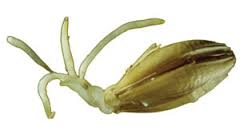G is for germination:
 |
| Germinating barley. Picture courtesy of Biokemi. |
H is for Hefeweizen:
This Bavarian beer style is often the catalyst for turning many occasional beer drinkers into complete craft enthusiasts. Brewed wth wheat instead of barley, Hefeweizens use sexual yeast to produce a sweet and spicy character likened to a banana/clove combination. Low bitterness levels contribute to this beer's popularity among those who are "new to beer."
 |
| Hefeweizens are served in Bavarian Weizen glasses. |
I is for IBU:
 |
| The IBU equation. Picture courtesy of IPABeer.com. |
IBU stands for International Bitterness Units, and uses a numerical range to indicate a beer's amount of Hoo bitterness. Since bitterness often influences a customer's choice of beer, IBUs, which generally fall between 10 and 120, are often printed on bottles and beer menus. When comparing beers, you may find that some beers will taste more bitter than those with higher IBUs. This is because bitterness is also influenced by the type and amount of malt used.

Thanks I have taste this and agree with you a good new belgium beer stylish and good smell - really awesome beer.
ReplyDelete